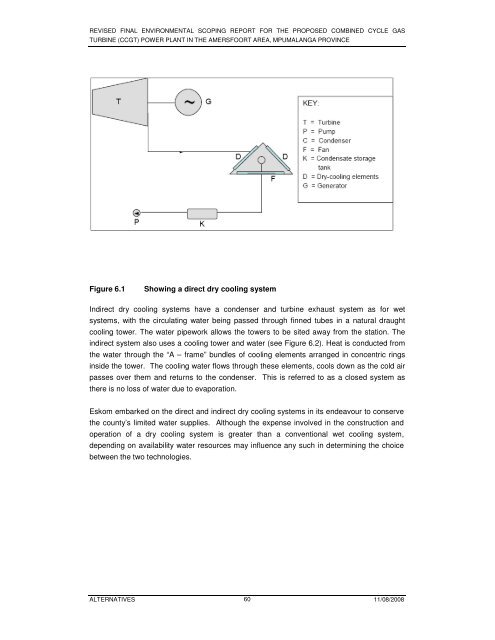Final ESR - Part 2 - Eskom
Final ESR - Part 2 - Eskom
Final ESR - Part 2 - Eskom
Create successful ePaper yourself
Turn your PDF publications into a flip-book with our unique Google optimized e-Paper software.
REVISED FINAL ENVIRONMENTAL SCOPING REPORT FOR THE PROPOSED COMBINED CYCLE GAS<br />
TURBINE (CCGT) POWER PLANT IN THE AMERSFOORT AREA, MPUMALANGA PROVINCE<br />
Figure 6.1 Showing a direct dry cooling system<br />
Indirect dry cooling systems have a condenser and turbine exhaust system as for wet<br />
systems, with the circulating water being passed through finned tubes in a natural draught<br />
cooling tower. The water pipework allows the towers to be sited away from the station. The<br />
indirect system also uses a cooling tower and water (see Figure 6.2). Heat is conducted from<br />
the water through the “A – frame” bundles of cooling elements arranged in concentric rings<br />
inside the tower. The cooling water flows through these elements, cools down as the cold air<br />
passes over them and returns to the condenser. This is referred to as a closed system as<br />
there is no loss of water due to evaporation.<br />
<strong>Eskom</strong> embarked on the direct and indirect dry cooling systems in its endeavour to conserve<br />
the county’s limited water supplies. Although the expense involved in the construction and<br />
operation of a dry cooling system is greater than a conventional wet cooling system,<br />
depending on availability water resources may influence any such in determining the choice<br />
between the two technologies.<br />
ALTERNATIVES 60<br />
11/08/2008
















